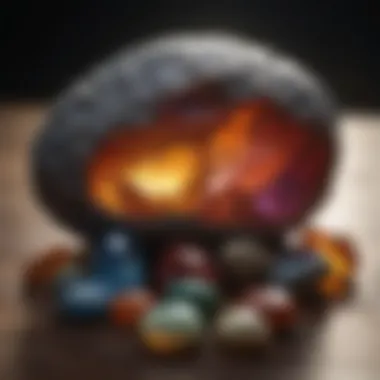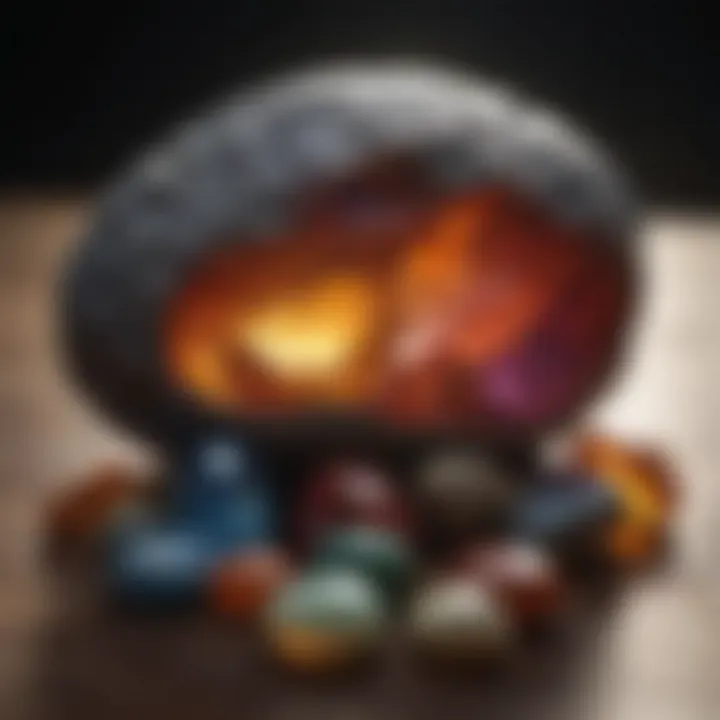Healing Stones: Ancient Wisdom Meets Modern Science


Intro
Stones have long fascinated humanity. From their alluring colors and intricate patterns to their solidity and strength, they have been revered across cultures for centuries. Today, many cherish gemstones not just for their beauty but also for their so-called healing properties. This article embarks on a journey through time, tracing the roots of stone usage and examining contemporary beliefs surrounding their benefits.
The connection between healing and stones is as old as civilization itself, with ancient practices often intertwining with spiritual beliefs. While skeptics question the scientific validity of these claims, a significant community continues to explore the potential effects of gemstones on physical and emotional well-being. By diving into this multifaceted relationship, we aim to present a balanced perspective on both historical and modern applications of stones in wellness practices.
Gemstone Overview
Definition of Gemstones
Gemstones, often defined as minerals or organic materials refined for adornment, are valued for their rarity and beauty. Each stone possesses unique characteristics—color, clarity, cut, and carat, which determine its aesthetic and economic worth. However, beyond their visual appeal, many believe these stones harbor latent energies that can impact their surroundings.
Classification of Gemstones
Gemstones can be categorized in several ways, each providing distinct insight into their properties and potential uses:
- Precious vs. Semi-Precious: Traditionally, diamonds, rubies, sapphires, and emeralds are labeled precious, while others like amethyst and turquoise fall under semi-precious.
- Organic vs. Inorganic: While most gemstones are inorganic minerals, some, like pearls and amber, are organic in origin.
- Natural vs. Synthetic: Natural gemstones form over millions of years, whereas synthetic ones are lab-created, often mimicking the genuine articles.
Understanding these classifications opens the door to deeper appreciation, enticing gemstone enthusiasts to explore their rich tapestry of colors, textures, and histories.
Historical Significance
Origins of Gemstone Use
Every civilization has its lore surrounding gemstones. The Egyptians, for instance, crafted exquisite jewelry imbued with the belief that certain stones possessed protective qualities. Turquoise, often found in burial garments, symbolized protection and was thought to ensure safe passage into the afterlife.
Furthermore, the Greeks associated particular stones with their gods, believing that amethyst could ward off drunkenness and keep one clear-headed. It was widely used by religious leaders to signify sobriety and clarity of thought.
Cultural Insights: Gemstones in Ancient Civilizations
The prominent role of gemstones in ancient cultures is still felt today. Consider the following:
- Ancient Egypt: Gemstones were used for adornment, as talismans, and in burial rituals.
- Chinese Culture: Jade, revered for its beauty and resistance, symbolized purity, wisdom, and virtue.
- Indian Traditions: The Navaratna, or nine gems, are believed to enhance different planetary influences.
"Stones are the bones of the earth and can hold the memories of time."
Examining these historical usages not only enriches our understanding of gemstones but also emphasizes their ongoing significance in modern applications.
Preamble to Stones and Healing
The practice of using stones and crystals for healing has roots that run deep into the fabric of human history. As we embark on this exploration, it's essential to recognize that the connection between human beings and stones transcends mere physical properties. Instead, it encompasses a rich tapestry of cultural significance, historical context, and emotional resonance. In this article, we will peel back the layers to reveal how stones have been employed as tools for wellness, healing, and spiritual connection over countless generations.
Rather than viewing these minerals solely as geological formations, we ought to appreciate how they symbolize much more: resilience, grounding, and transformation. The importance of this topic lies in its potential to enlighten both novices and seasoned enthusiasts alike. Understanding this connection not only enriches our appreciation of gemstones but can also enhance our own well-being.
The Significance of Healing in Human Culture
Throughout nearly every culture and civilization, the quest for healing has been a universal pursuit. From the ancient Egyptians who adorned their tombs with stones like lapis lazuli, believed to offer protection in the afterlife, to the Indigenous tribes utilizing local minerals in their healing rituals, stones have consistently held a significant role in various healing traditions. They serve as tangible symbols of hope, comfort, and spiritual guidance.
In contemporary society, the growing interest in holistic practices brings stones back into the spotlight. With more people leaning towards alternative medicine, the healing properties attributed to stones and crystals are often seen as pathways to emotional equilibrium and physical wellness. Thus, the cultural significance of healing continues to evolve, incorporating ancient wisdom while adapting to modern needs.
Historical Uses of Stones in Healing Practices
The historical applications of stones for healing are as varied as the stones themselves. Many cultures employed specific stones for particular ailments or blessings, often passed down through oral traditions. For instance, the ancient Greeks used amethyst to ward off intoxication and promote clarity of mind. Similarly, Native Americans have long revered turquoise as a protective stone, believed to offer strength and healing.
In the Middle Ages, healers and herbalists often paired stones with herbs to amplify their effectiveness. This period saw the integration of astrological influences where specific gemstones corresponded with planetary alignments, further embedding these practices in the mindset of the era.
Even today, the use of stones in healing is not merely a relic of the past; practices such as crystal healing integrate historical wisdom with modern therapeutic techniques. Though skeptics may question the efficacy, the cultural richness behind these practices merits exploration, presenting stones not as mere objects but as connectors of ancient traditions to present-day wellness approaches.
"Stones are the bones of the Earth; they tell tales long forgotten and offer healing not just to the body, but to the spirit."
As we move through the subsequent sections of this article, we will delve into the specific attributes and classifications of gemstones, their interplay of color and energy, and the concrete applications of these ancient practices in modern contexts.
Understanding Gemstones
Gemstones hold a unique position in the realm of healing practices and alternative therapies. Their beauty is not simply for aesthetic purposes; these stones embody potential benefits that resonate deeply with the mind, body, and spirit. Understanding gemstones transcends merely identifying their types or colors; it offers a window into their histories and the connections they've forged with cultures throughout the ages. This section delves into the facets of gemstones and their significance in contemporary healing narratives.
Classification of Gemstones
Precious vs. Semi-Precious Stones
The division between precious and semi-precious stones often shapes one's perception of value and rarity in gemstones. Precious stones, like diamonds, sapphires, emeralds, and rubies, are esteemed for their durability and beauty. Their scarcity drives the market, making them a popular choice for investment and adornment. On the other hand, semi-precious stones, including amethyst and citrine, offer diverse colors and patterns, often at a more accessible price point.
The key characteristic here is rarity. Precious stones are less common, which can amplify their significance in various healing rituals. For instance, during ancient times, owning a diamond typically symbolized ultimate power and protection against malevolent forces. However, semi-precious stones have blossomed in popularity due to their accessibility and perceived energies, making them more readily usable for collectors and enthusiasts alike. One unique feature is that semi-precious stones often provide varied benefits that cater to specific emotional and spiritual needs, thus empowering individuals who seek personal healing practices.
Types Based on Composition


The classification of gemstones based on composition introduces another layer of understanding. Here, stones are categorized mainly by their chemical structure. For instance, quartz, a highly varied mineral, may manifest as various forms, such as amethyst or rose quartz, based on impurities present within. This characteristic allows for distinct energetic properties associated with each type.
The value lies in recognizing that the composition of a stone greatly influences its healing properties. For example, many believe that the silicon dioxide found in quartz enhances clarity of thought and amplifies intention, making these stones beneficial for meditation. However, one must consider the complexities; the composition of gemstones might also lead to challenges like market confusion, as similar-looking stones can be misidentified.
Regional Variations
Regional variations in gemstone availability inject an intriguing dynamic into the healing properties discussion. Different regions produce unique varieties of stones that often come with their cultural significance. For example, turquoise is predominantly found in North America and has long been considered a protective stone among indigenous cultures, while the beautifully blue lapis lazuli can primarily be found in Afghanistan, held sacred for fostering spiritual enlightenment.
The key characteristic here is the localized beliefs surrounding these stones. The cultural narratives substantially influence how different societies integrate stones into their healing practices. Such features reveal that not only do gemstones embody physical traits, but they also encapsulate ancestral wisdom. However, this regionalization could also present some setbacks for enthusiasts; sourcing authentic stones amid replicas can be a daunting endeavor.
The Role of Color and Energy
Color Theory in Gemstones
Color is a fundamental aspect of gemstone healing, integral to the energetic properties they are believed to possess. It’s often thought that colors correlate directly with different chakras, the energy centers of the body. For instance, red stones like garnet is often tied to the root chakra, associated with grounding and vitality, while purple stones like amethyst resonate with the crown chakra, linked to spiritual awakening and consciousness.
Such a vibrant spectrum of colors allows for tailored healing practices. By selecting stones that symbolize or enhance a desired intention based on color, individuals can attempt to amplify their efforts through metaphysical means. However, it should be noted that color perception can be subjective; the stone one considers soothing might differ vastly from another’s point of view.
The Vibrational Energy of Stones
The vibrational energy inherent in gemstones is another essential aspect worth unraveling. Each stone purportedly resonates at a unique frequency, contributing to its energetic profile. For example, clear quartz is believed to resonate with higher frequencies and is often used to amplify other stones' energies during healing sessions.
Understanding this vibrational aspect can vastly inform how stones are applied in personal practices and rituals. It encourages a more exploration-focused approach to healing, encouraging users to experiment with various combinations of stones to find synergy that suits their specific needs. However, the notion of vibrational energy may attract skepticism due to a lack of empirical backing, urging users to approach with an open mind yet critical judgment.
In summary, understanding gemstones entails recognizing their classification, regional significance, and vibrational properties, each enriching the overall narrative surrounding healing. Knowledge of these elements enhances the appreciation and practical application of stones in daily life, fostering a deeper connection to the ancient practices that intertwine with contemporary healing methodologies.
Key Stones and Their Healing Properties
Exploring the healing properties of stones involves not just an understanding of the stones themselves but also a recognition of their meanings, uses, and cultural significance. Each stone comes with unique characteristics, potentially beneficial properties, and historical significance, making them rather intriguing for many enthusiasts. The allure of these stones lies in their ability to resonate with individuals on different levels, be it emotional, spiritual, or physical.
Amethyst: Calming Energy
Uses in Stress Relief
Amethyst is often regarded as a powerful tool in stress relief. With its tranquil purple hue, it embodies a sense of peace and calm. Many people place amethyst under their pillows at night or keep it on their desks during the day to promote a soothing atmosphere. This stone is believed to combat anxiety and stir a sense of tranquility. Its ability to mitigate the noise in one's mind can be particularly beneficial to those feeling overwhelmed by daily pressures. However, while some find immediate relief, others may require a bit of time to feel tangible effects.
Historical Significance
Historically, amethyst has been valued for its purported ability to ward off intoxication. In ancient times, Greeks wore amethyst to prevent drunkenness and promote clear thinking. Furthermore, it has been associated with various deities and has been incorporated in Christian contexts as well. The stone's deep-rooted connections to both royalty and spirituality enhance its majestic image, making it a standout among healing stones.
Rose Quartz: Heart Healing
Emotional Healing Properties
Rose quartz is often dubbed the "love stone," and its emotional healing properties are well recognized among gemstone enthusiasts. It's said to open the heart chakra, fostering feelings of compassion and harmony. By cultivating self-acceptance and self-love, this stone can make a significant impact on one's emotional well-being. While rose quartz is often gifted to loved ones, its real potency perhaps lies in how it helps individuals develop a loving relationship with themselves.
Applications in Self-Love and Compassion
In modern applications, rose quartz is increasingly used as a reminder of self-kindness. Practices like meditation with the stone or wearing rose quartz jewelry serve as daily affirmations of love and care. However, it doesn't always work wonders for everyone; some might feel that its effects are subtle or require consistent intention and focus to manifest fully.
Citrine: Manifestation and Abundance
Connection to Prosperity
Citrine is commonly regarded as the stone of abundance and manifestation. Known for its warm, golden color, it embodies the vitality of sunlight, believed to attract prosperity into one's life. Many people place citrine near cash or business spaces to invoke wealth. While some practitioners swear by its effects in financial matters, critics often point out that acquiring wealth is multifaceted, and a stone alone may not bring about financial change.
Use in Positive Affirmations
The practice of using citrine during positive affirmations has gained traction in self-help circles. Affirmations coupled with citrine can amplify the intended message, instilling a greater belief in one's ability to manifest dreams into reality. Many who integrate this approach feel a sense of purpose while wielding the stone; however, divergence in belief about the efficacy of affirmations can lead to mixed results among individuals.
Black Tourmaline: Protection and Grounding
Defense Against Negativity
Black tourmaline is often recognized for its protective qualities, acting as a shield against negative energies. Those sensitive to the emotional ups and downs of their surroundings often carry black tourmaline to maintain equilibrium. Additionally, it is said to help clear the mind of confusion, making it a go-to stone for those navigating tough environments. Yet, relying solely on this stone can sometimes lead individuals to overlook other essential coping mechanisms.
Grounding Techniques
In holistic practices, black tourmaline serves as a grounding stone, anchoring individuals during meditation or chaotic times. Techniques like placing the stone on the root chakra or holding it while sitting on the ground help deepen the connection with the Earth. Yet, some may find that the experience isn't as impactful or immediate as they would hope, suggesting that personal intention and mindfulness play crucial roles in its effectiveness.
Lapis Lazuli: Wisdom and Intuition
Enhancing Mental Clarity
Lapis lazuli, with its deep blue hue, has long been linked to enhancing mental clarity and stimulating the intellect. Aligned with wisdom, it supports individuals seeking deeper insights into their thoughts and feelings. Users often reference its help in decision-making processes or problem-solving, making it a valuable ally for intellectual pursuits. However, for some, the connection may require time to strengthen and grow.
Cultural Importance Across Ages


Across various cultures, lapis lazuli has been revered for its beauty and significance. In ancient Egypt, it was used in burial masks and ornaments, symbolizing truth and wisdom. Such cultural roots provide it with a richness that many find profoundly meaningful. Still, the reliance on its historical attributes might not resonate with everyone, as some might approach it strictly from a contemporary and personal viewpoint.
Practical Applications of Healing Stones
Understanding how to effectively utilize healing stones in daily life is a cornerstone of appreciating their benefits. This section highlights practical ways to incorporate stones into routine practices, ultimately making their metaphysical properties accessible for enhancing physical and emotional well-being. By weaving these stones into everyday scenarios, enthusiasts can experience firsthand the potential healing powers attributed to them.
Incorporating Stones into Daily Life
Crystal Grids
Crystal grids stand out as a contemporary method for harnessing the energies of several stones to form a synergistic effect. At their core, crystal grids arrange multiple stones in specific geometric patterns that can amplify intentions. The unique feature of this practice lies in its ability to blend the individual energies of each stone, creating a more potent overall effect. This collective energy is often used for enhancing specific goals—be it love, prosperity, or protection.
One major characteristic that makes crystal grids appealing is the customizable nature of their designs. Each grid can be tailored to align with personal desires, making it a creative outlet for practitioners. However, they do require a bit of planning and knowledge about each stone's properties. Without proper understanding, one might arrange stones without maximizing their potential benefits.
Advantages of crystal grids include the following:
- Clarity of Intention: A grid can serve as a visual representation of intentions, channeling focus and energy towards desired outcomes.
- Enhanced Energy Flow: The geometric patterns can help direct energy in a way that individual stones alone may not achieve.
On the downside, some users may find the learning curve steep, particularly if they are fresh to crystal work. Still, many find that once mastered, grids offer profound results over time.
Jewelry and Personal Adornments
Jewelry adorned with healing stones often serves dual purposes. Not only does it enhance one's appearance, but it also acts as a constant reminder of personal intentions or healing goals. The key characteristic of using stones in jewelry lies in their everyday visibility; they are worn close to the body, facilitating a continuous energy exchange.
What sets this method apart is its accessibility. Jewelry can be stylish while serving practical, therapeutic functions. For example, a bracelet made of rose quartz can promote emotional healing while looking beautiful.
However, personal adornments are not without their complications. Often, the type and quality of stones used in jewelry can vary significantly, impacting effectiveness. It's advisable to seek pieces that feature genuine stones from reputable sources to ensure you're getting the right kind of energy.
Moreover, benefits of incorporating stones into jewelry include:
- Convenience: Wearing healing stones allows for continual exposure to their energies without needing a separate practice or ritual.
- Personalize Healing: Different styles allow individuals to express their personality while focusing on their healing journey.
While some might argue that jewelry, depending on its design, could be less effective than focused crystal work, many find that the daily reminder keeps healing intentions at the forefront of their minds.
Using Stones in Meditation and Mindfulness
Techniques for Effective Use
When implementing healing stones in meditation, it's essential to have effective techniques that facilitate deeper connections with the stones' energies. Proper methods can enhance the meditative experience, allowing practitioners to focus and achieve a resonance with their selected stones.
This segment explores various practices that enthusiasts can adopt, such as placing stones on specific chakras or holding them during focused breathing. Each method can tailor how one interacts with the stones, creating a unique experience each time. The key characteristic here is the integration of stones into the meditative process, making them allies in achieving tranquility and heightened awareness.
Some notable techniques include:
- Holding Stones: Simply grasping a stone can ground you, creating a tangible link to the earth as you meditate.
- Placement on Body: Situating stones on specific areas can balance energy and direct healing.
While these practices are beneficial, there is a learning curve to feeling the stones’ energies effectively. Various practices resonate differently with individuals, making exploration key.
Setting Intentions with Crystals
Setting intentions during sessions with stones can profoundly enhance focus on desired outcomes. This aspect emphasizes awareness, illustrating how thoughts and energies can intertwine to manifest certain desires. The unique feature of setting intentions lies in its potential to create a personal narrative around each stone, linking them to specific emotional or physical goals.
Taking a few moments to write down or verbalize intentions makes this practice all the more effective. It transforms the stones into tangible representations of aspirations. This method is often favored for its simplicity and effectiveness, lending to the belief that focused energy can yield results.
Key benefits of this practice include:
- Clarification of Goals: Articulating intentions helps the practitioner crystallize goals that may otherwise be vague or fleeting.
- Empowerment: Seeing intentions manifest, however subtly, can reinforce belief in the stones' powers and one’s own abilities.
On the flip side, setting overly broad or unrealistic intentions can lead to disappointment, highlighting the importance of specificity and mindfulness in this practice.
"The real magic lies not just in the stones but in the intent behind our actions."
In sum, the practical applications of healing stones create a beautiful tapestry of opportunities for individuals to engage with and harness the healing properties of these ancient elements. Through rituals, daily reminders, and meditative practices, stones can become valuable allies in one's health and well-being journey.
Scientific Perspectives on Healing with Stones
The debate surrounding the healing properties of stones isn’t new—it stretches across centuries. This section delves into the scientific evaluations behind these claims, reflecting on how evidence supports, or at times questions, the widespread beliefs about gemstones. Understanding the scientific perspective is essential, as it not only enriches our appreciation of these stones but also provides a basis for considering their roles in modern wellness culture.
Examining Scientific Research
Studies on Stone Effectiveness
Evaluating the effectiveness of stones in healing involves looking at various scientific studies. While some researchers have found correlations between certain stones and positive outcomes in emotional and physical health, results are often inconclusive. The focus of these studies tends to lean heavily on anecdotal evidence, pushing the boundaries of scientific rigor.
A notable characteristic of these studies is that they frequently measure subjective experiences rather than clear scientific data. For instance, individuals tend to report feeling more relaxed or centered when in possession of specific stones, like amethyst or rose quartz. This subjectivity can make it hard to generalize findings for broader health claims. However, this approach remains popular in this field, as many feel that personal experiences hold significant value.
One unique feature of these investigations is the variance in individual responses to stones. What calms one person might agitate another, which presents a fascinating yet challenging factor when trying to establish overall effectiveness. As such, these studies—while beneficial for continuing the conversation around healing stones—face criticisms regarding the lack of empirical backing in many instances.


Placebo Effect in Healing
The role of the placebo effect cannot be understated in conversations about healing stones. This phenomenon can dramatically impact perceived outcomes, essentially demonstrating how belief in a stone's power can lead to tangible changes in one’s mental and emotional state. In studies where environmental stressors are controlled, individuals who believe in the efficacy of their stones often report better outcomes than those who approach the practice skeptically.
This is an integral characteristic in understanding the appeal of healing stones—people want to believe in their power, and the placebo effect capitalizes on this. It represents a beneficial angle for this article, as it highlights the connection between belief systems and wellness. However, the downside emerges when individuals attribute healing to stones while potentially overlooking significant medical conditions needing tangible treatments.
Skepticism and Criticism
Challenges in Validating Claims
Skepticism around the efficacy of stones stems from the challenges in validating their healing claims. One prominent issue is the lack of standardized research protocols. Each stone and its supposed benefits have different anecdotal backgrounds, complicating systematic investigations. This creates a fertile ground for skepticism, especially among medical professionals demanding rigorous data.
A key aspect of these challenges involves the variability in personal belief systems. While one individual may be deeply attached to the idea of healing crystals, another may completely dismiss them. This dichotomy in experiences puts stones in a precarious position when it comes to establishing their validity as healing agents. On the upside, it's these discussions that encourage more educated debate about alternative healing methods, but they often lead to confusion rather than clarity.
Common Misconceptions
Common misconceptions surrounding healing stones often stem from overblown claims regarding their benefits. For example, some sources contend that carrying specific stones can cure ailments like anxiety or chronic pain. These sweeping claims are not only misleading but can also detract from the more nuanced ways that stone healing might be beneficial.
Understanding these misconceptions helps clarify the true nature of what stones can provide—primarily emotional support and a sense of personal empowerment. Furthermore, addressing these misconceptions encourages a more informed exploration of the subject, ensuring that the conversation remains grounded. Misunderstanding their role can lead individuals to neglect conventional treatments that could vastly improve their health.
"The power of belief and intention cannot be ignored; healing stones serve as facilitators for personal journeys rather than miracle cures."
Connecting Stones to Spiritual Practices
Understanding the connection between stones and spiritual practices is essential to fully appreciating their role in both ancient and contemporary healing methodologies. Throughout history, various cultures have utilized stones not just for their physical attributes, but for their energetic potential. This intricate relationship highlights how stones are woven into the fabric of spiritual traditions, serving as both tools and symbols to facilitate healing and inner exploration.
Cultural and Spiritual Connections
Traditions Around the World
From the labyrinths of ancient Greece to the sacred temples of India, the cultural practices surrounding stones differ astonisshily yet speak to a universal truths about healing. In many indigenous cultures, particular stones are seen as gifts from nature, imbued with the energy of the Earth itself. For example, in Native American traditions, stones like turquoise are not only cherished as valuable adornments but are also believed to harness protective and healing energies.
The key characteristic of these traditions is their emphasis on community and spiritual connection. The rituals involving stones are often collective, bringing individuals together to harness shared energies for healing. This aspect contributes significantly to their popularity within spiritual contexts, as they foster both personal and communal healing.
One unique feature of these practices is the use of stones in ceremonies that articulate a connection to the natural world. Engaging with these traditions provides an opportunity to cultivate respect for our environment and a deeper understanding of our place within it. However, the disadvantage lies in the potential oversimplification or commercialization of these practices in modern settings, which sometimes overlooks their rich cultural significance.
Modern Spirituality and Stones
As we look at modern spirituality, the narrative surrounding stones evolves yet continues to echo the wisdom of the ancients. In today's wellness-oriented society, the integration of stones for personal empowerment and mindfulness is becoming increasingly prevalent. The key characteristic of current practices is their accessibility; individuals are encouraged to work with stones at home, in meditation, or even by simply carrying them around.
The uniqueness of modern spirituality with stones is its integration into daily life — people are using them not only for ceremonial purposes but also in everyday activities as reminders of their intentions. This ease of access has made stones a relatable choice for many. Yet, one potential disadvantage is the risk of superficial engagement, where individuals may collect stones for aesthetics rather than their intended energetic properties.
Healing Rituals and Ceremonies
Rituals from Different Cultures
Rituals play a pivotal role in many cultures when it comes to the use of stones. For instance, in Feng Shui, specific stones are placed in particular areas of homes or offices to enhance energy flow, reflect balance, and invite tranquility. This key characteristic emphasizes the belief in stones as conduits of energy that can influence our environments.
The benefit of these rituals is the intention behind them — they serve as a physical reminder of our goals and desires. However, one must consider that different cultures approach these rituals with varying degrees of depth, which can sometimes lead to misunderstandings about their true purpose in one culture versus another.
Personalizing Healing Practices
The essence of personalizing healing practices is adapting various elements from different spiritual traditions to create a unique journey. Each individual's experience with stones can be different, reflecting their personal beliefs and healing needs. This key characteristic allows for a tailored approach to spiritual healing, ensuring that practices resonate with the individual.
The unique feature of personalizing these practices means utilizing crystals that one feels drawn to the most, whether in meditations, affirmations, or as part of one's personal space. The advantages are clear: these practices become meaningful and empowering. However, the challenge lies in discerning between spiritual guidance and personal whim, which sometimes leads to less effective healing outcomes.
In summary, understanding these connections between stones and spiritual practices enriches our knowledge of their role in healing, while reminding us of both their ancient roots and modern applications.
Closure: The Future of Stones in Healing
As we look ahead into the future of healing practices, the significance of stones in the wellness arena is becoming hard to ignore. The renewed interest in holistic approaches has sparked conversations around the potential benefits of incorporating gemstones into daily life, especially in modern healthcare settings. Practitioners are starting to acknowledge that while science is still catching up, there is substantial anecdotal evidence supporting the positive effects of these natural elements on emotional and physical well-being.
Emerging Trends in Gemstone Usage
Integration with Modern Wellness
The trend of integrating gemstones into modern wellness practices is becoming more pronounced. This integration often occurs in wellness centers, spas, and therapy clinics where crystals are used alongside traditional therapies, such as reiki or acupuncture. The unique aspect of this integration is that gemstones aren't merely seen as decorative items; they are considered tools that help focus energy and enhance healing intentions.
One key characteristic of this trend is the growing popularity among urban dwellers who seek accessible methods to cope with the stressors of daily life. In an environment where people are often feeling overwhelmed, using stones can serve as a grounding technique, promoting relaxation and mental clarity. Though it may be dismissed by some, the practice holds a beloved spot in the hearts of many holistic practitioners and enthusiasts alike—it becomes almost a meditation in itself.
The advantage of integrating stones is that they offer a tactile element to wellness practices which can further enhance mindfulness. For example, holding a smooth piece of rose quartz during a meditation session can provide a soothing experience that allows stress to melt away. However, it’s crucial to note that while these practices are increasingly recognized, they need to be approached with discernment and respect for their historical and cultural significance.
Potential for New Research
On the horizon lies a promising opportunity for new research into the healing properties of stones. This potential is evident as more academic and clinical studies surface, aiming to establish empirical data on how these gemstones can influence human health. The insight gained could lend credibility to what many have already experienced firsthand and could propel specific claims into broader acceptance.
One of the key characteristics of this research avenue is the focus on multidisciplinary collaboration, combining fields like geology and psychology. As scientists begin to explore the vibrational frequencies emitted by different stones, there's excitement about discovering connections between these frequencies and emotional states or physical ailments. Another fascinating angle could be investigating how placebo effects play a role in enhancing the perceived benefits of gemstone use.
The unique feature of future research lies in its potential to formalize practices that were once considered fringe or purely anecdotal. That said, there are hurdles to navigate: funding for such specialized research might be limited, and some academics may remain skeptical. Balancing scientifically rigorous studies with the spiritual and subjective experiences of users of gemstones will be a challenge.
Final Thoughts
As this article draws to a close, it's clear that our understanding of healing stones is far from complete. From ancient practices steeped in tradition to modern applications that embrace holistic well-being, the journey of understanding stones continues to evolve. These natural elements represent not just beauty but a profound connection with wellness that invites both skepticism and excitement. As we move forward, the exploration of stones in healing, informed by both evidence-based research and cultural wisdom, may yield therapeutic practices that benefit a wide range of individuals seeking balance and healing in their lives.



